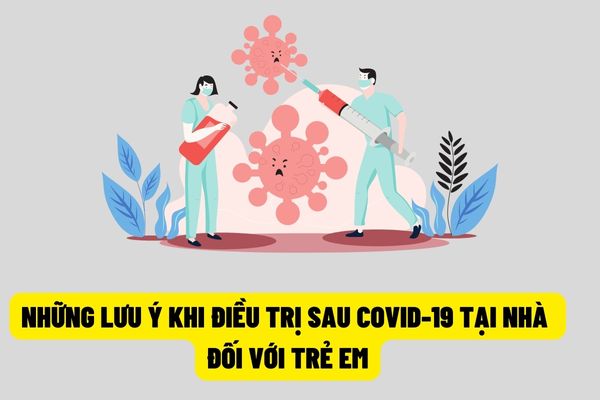What emergency measures should be taken when a child has difficulty breathing or is in a coma after contracting Covid-19 in Vietnam?
- What emergency measures should a child take after contracting Covid-19 in Vietnam with respiratory symptoms or coma?
- What issues should parents pay attention to to conduct post-Covid-19 in Vietnam treatment for children at home?
- In case children after being infected with Covid-19 in Vietnam show symptoms that cannot be treated with conventional measures, how should they be handled?
- Notes on home health monitoring and follow-up visits for children after contracting Covid-19?
What emergency measures should a child take after contracting Covid-19 in Vietnam with respiratory symptoms or coma?
Pursuant to subsection 3.2, Section III of the Guidelines issued together with Decision 1856/QD-BYT in 2022 of the Ministry of Health, there are instructions on immediate emergency measures for children after being infected with Covid-19 in Vietnam such as: after:
“III. TREATMENT
…
3.2. Treatment
a) Give first aid immediately when the patient shows emergency signs
- Respiratory support
+ Breathing oxygen through the nose, non-invasive breathing keeps SpO2 94-98%.
+ Intubation, mechanical ventilation when indicated.
- Shockproof if available
+ Infusion of Ringer Lactate or Sodium Chloride 0.9% rapidly 20 ml/kg/15-60 minutes.
Intravenous adrenaline (cold shock) or noradrenaline (warm shock).
Broad-spectrum intravenous antibiotics when infection is suspected.
- Coma:
+ Safe posture.
+ Open airway.
+ Inhale oxygen.
+ Treat hypoglycemia if present with 30% IV Glucose dose 1-2 ml/kg then 10% Glucose infusion.
Accordingly, based on the symptoms encountered by the patient to determine timely emergency measures according to the content of the above guidance.

What emergency measures should be taken when a child has difficulty breathing or is in a coma after contracting Covid-19 in Vietnam?
What issues should parents pay attention to to conduct post-Covid-19 in Vietnam treatment for children at home?
Pursuant to subsection 3.2, Section III of the Guidelines issued together with Decision 1856/QD-BYT in 2022 of the Ministry of Health, there are guidelines on outpatient treatment for children after being infected with Covid-19 as follows: :
“III. TREATMENT
…
3.2. Treatment
…
c) Outpatient treatment
The majority of people infected with COVID-19 have mild symptoms, are treated on an outpatient basis, and symptoms will clear up after 2-8 weeks.
- Indication for hospitalization
There are signs of danger all over the body
+ There are serious warning signs according to the specialist.
COVID-19-associated multisystem inflammatory syndrome in children (MIS-C).”
Thus, parents need to pay attention to the appropriate outpatient treatment methods for each type of symptoms appearing in children after being infected with Covid-19 according to the above guidelines.
Accordingly, in case a child has systemic danger signs, specialist warning signs or multisystem inflammatory syndrome associated with COVID-19 in children (MIS-C), it is necessary to take the child to the hospital. immediately for safety.
In case children after being infected with Covid-19 in Vietnam show symptoms that cannot be treated with conventional measures, how should they be handled?
Pursuant to subsection 3.2, Section III of the Guidelines promulgated together with Decision 1856/QD-BYT in 2022 of the Ministry of Health, there are instructions for handling cases in which conventional treatment measures cannot be applied. with children after contracting Covid-19 as follows:
“III. TREATMENT
…
3.2. Treatment
…
d) Appointment to be transferred to a specialist or to a provincial general hospital, a last-line pediatric specialty
Post-COVID-19 cases requiring respiratory support, or requiring intensive specialized intervention, or symptoms lasting more than 2 weeks that do not respond to conventional treatment measures, require specialist consultation or referral. upline so that children can receive better treatment.
* Guide and conduct mental health screening tests for children according to appropriate age such as DASS 21 (evaluating 3 factors: level of depression, anxiety, stress), PSS-10-C (Stress) due to COVID-19 (See Appendix 1)”
Accordingly, it is necessary to transfer to a specialist or provincial general hospital, the last-line pediatric specialty according to the instructions when the symptoms appear according to the above content.
Notes on home health monitoring and follow-up visits for children after contracting Covid-19?
Pursuant to subsection 3.2, Section III of the Guidelines issued together with Decision 1856/QD-BYT in 2022 of the Ministry of Health, guiding measures for home monitoring and follow-up examination for children after being infected with Covid-19 - 19 as follows:
“III. TREATMENT
…
3.2. Treatment
…
dd) Guidance for home monitoring and follow-up examination
- Instructing mothers to take care of children at home:
+ Take prescription medication.
+ Complete nutrition, micronutrients, vitamins.
+ Exercise, encourage movement.
- Get enough sleep, reduce stress.
- Always encourage children.
- Instructing signs of emergency or serious need to take the child to a medical facility or emergency hospital immediately.
- Guide to follow-up by appointment.
Follow-up and re-examination of MIS-C
- Echocardiography check: If there are coronary abnormalities or abnormalities on echocardiography (decreased heart function, pericardial effusion, valvular regurgitation...) to the cardiology clinic.
- If not abnormal: Aspirin dose 3-5 mg/kg/day and Prednisone 1mg/kg in the first 5 days, reduce dose by 0.5 mg/kg in the next 5 days and then stop.
- Follow up every 1-2 weeks for the first month. After that, if it goes well, re-examination every month for 3-6 months."
Accordingly, the conduct of home monitoring and re-examination for children after being infected with Covid-19 is carried out according to the above guidance.
LawNet


